| کد مقاله | کد نشریه | سال انتشار | مقاله انگلیسی | نسخه تمام متن |
|---|---|---|---|---|
| 5208634 | 1382593 | 2009 | 66 صفحه PDF | دانلود رایگان |
عنوان انگلیسی مقاله ISI
Thermal stability and flame retardancy of polyurethanes
دانلود مقاله + سفارش ترجمه
دانلود مقاله ISI انگلیسی
رایگان برای ایرانیان
کلمات کلیدی
IPDINDIDIETMPTDIMoCAHDIMDIBEPDMPAPPGMMTDibutyltin dilauratePUDPOSSMWNTTPUhexamethylene diisocyanateH12MDIPTMGDBTDLbAPsTGATEOSCNTtetraethoxysilaneSWNTTHF1,4-butanediol - 1،4-ButanediolPolyhedral oligomeric silsesquioxane - sylesquioxane oligomeric polyhedral استInductive effect - اثر القاییisophorone diisocyanate - ایزوفرون دی ایزوسیاناتHard segment - بخش سختSoft segment - بخش نرمTetrahydrofuran - تتراهیدروفورانThermogravimetric analysis - تجزیه و تحلیل ترموگرافیChain extender - تقویت کننده زنجیره ایtoluene diisocyanate - تولئین دی ایزوسیاناتDielectric constant - ثابت دی الکتریکTransition state - حالت گذارglass transition temperature - دمای انتقال شیشهMelting Temperature - دمای ذوبFlame retardancy - عقب ماندگی شعلهFullerenes - فولون هاMethylene diphenyl diisocyanate - متیلن دیفنیل دی ایزوسیاناتMontmorillonite - مونت موریلونیتCarbon nanotube - نانولوله کربنیSingle-walled carbon nanotube - نانولوله کربنی تک دیوارهMulti-walled carbon nanotube - نانولوله کربنی چند دیوارهNanocomposite - نانوکامپوزیتHexachlorocyclotriphosphazene - هگزا کلروسیلیکوترری فسفسنThermal stability - پایداری حرارتیPolyurethane dispersion - پراکندگی پلی ¬ اورتانpolyethylene glycol - پلی اتیلن گلیکولPolypropylene glycol - پلی پروپیلن گلیکولPEG - پلیاتیلن گلیکول Polyurethane - پلییورتان هاFunctionalization - کارکردنExpandable graphite - گرافیت قابل انعطاف
موضوعات مرتبط
مهندسی و علوم پایه
شیمی
شیمی آلی
پیش نمایش صفحه اول مقاله

چکیده انگلیسی
The thermal stability and flame retardancy of polyurethanes is reviewed. Polyurethanes (PUs) are an important class of polymers that have wide application in a number of different industrial sectors. More than 70% of the literature that deals with PUs evaluates their thermal stability or flame retardancy and attempts to provide a structure-property correlation. The importance of studying thermal degradation, understanding the processes occurring during thermal stress as well as the parameters affecting the thermal stability of PUs are essential in order to effectively design polyurethanes having tailor-made properties suitable for the particular environment where they are to be used. A detailed description of TGA, TGA-MS and TGA-FTIR methods for studying the decomposition mechanism and kinetics is also a part of this review. In general, thermal decomposition of PUs begins with the hard segment (HS) and a number of parameters govern a polyurethane's thermal stability. Detailed description of the parameters such as HS, soft segment (SS) and chain extender (CE) structure and molecular weight, NCO:OH ratio, catalyst nature and crosslink density that affect the nature of PU degradation is given. Descriptions of approaches to improve the thermal stability in PUs such as formation of poly(urethane-isocyanurate), poly(urethane-oxazolidone) and poly(urethane-imide) in addition to other methods such as PUs with an s-triazine ring or increased aromatic ring concentration, azomethane linkages as well as use of hyperbranched polyols as crosslinking agents is given. A part of the review is also concentrated on the improvement of thermal stability via hybrid formation such as the incorporation of appropriate amounts of fillers, e.g., nano-silica; Fe2O3; TiO2; silica grafting; nanocomposite formation using organically modified layered silicates; incorporation of Si-O-Si crosslinked structures via sol-gel processes; and the incorporation of polyhedral oligomeric silsesquioxane (POSS) structures into the PU backbone or side chain. Incorporation of carbon nanotubes (CNT) into PUs and the use of functionalized fullerenes in PUs are also described as these are the newest tools to obtain good thermal stability and flame retardancy. Part of the review also concentrates on the process that occurs during burning of PUs, flame retardant mechanisms and different additives or reactive type flame retardants used in the PU industry. The use and working function of expandable graphite and melamine as additive type flame retardants are shown. Description of the use of different reactive type organophosphorus compounds, cyclotriphosphazenes, aziridinyl curing agents in aqueous polyurethane dispersions (PUDs), organoboron compounds and organosilicon compounds for improving flame retardancy is also given.
ناشر
Database: Elsevier - ScienceDirect (ساینس دایرکت)
Journal: Progress in Polymer Science - Volume 34, Issue 10, October 2009, Pages 1068-1133
Journal: Progress in Polymer Science - Volume 34, Issue 10, October 2009, Pages 1068-1133
نویسندگان
D.K. Chattopadhyay, Dean C. Webster,